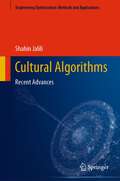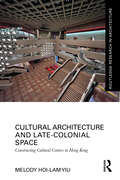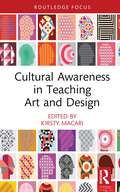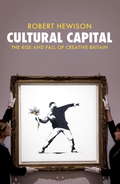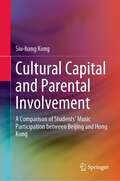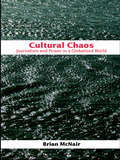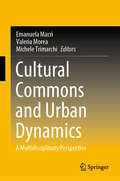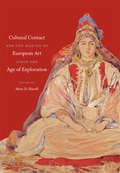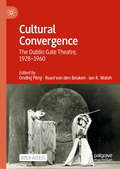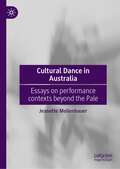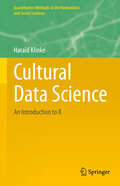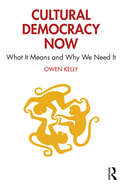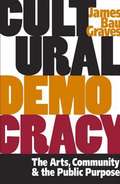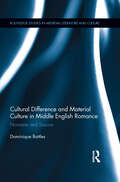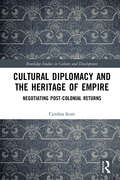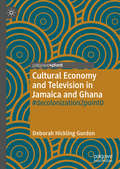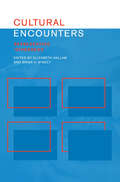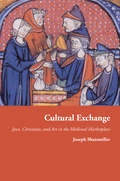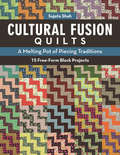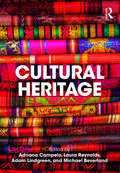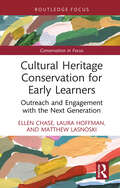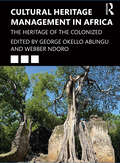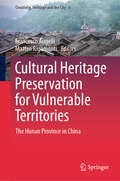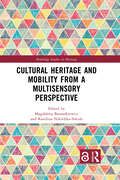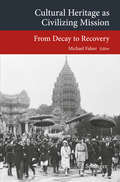- Table View
- List View
Cultural Algorithms: Recent Advances (Engineering Optimization: Methods and Applications)
by Shahin JaliliThis book covers the latest advances in Cultural Algorithms, their general framework, different variants, hybridized versions with other meta-heuristic and search techniques, and their applications. Cultural Algorithms are meta-heuristic numerical optimization techniques inspired by the bio-cultural evolutionary theory, in which both types of vertical and horizontal learning behaviors are modeled. The book includes well-briefed basics of optimization and theoretical backgrounds of Cultural Algorithms in its initial chapters and then discusses their applications in different branches of science and engineering. It provides detailed mathematical formulations and algorithmic pseudo-codes of hybridized, extended, and multi-population variants of cultural algorithms. The book will serve the research students, fellows, professors, and industry professionals to implement real-time applications of Cultural Algorithms.
Cultural Architecture and Late-Colonial Space: Constructing Cultural Centres in Hong Kong (Routledge Research in Architecture)
by Melody Hoi-lam YiuThis book offers the first in-depth study of three major Hong Kong public cultural architecture works, Tsuen Wan Town Hall, Shatin Town Hall and the Hong Kong Cultural Centre (HKCC), built in the late-colonial years.Recent developments at the West Kowloon Cultural District (WKCD) have attracted global attention to Hong Kong's cultural scene with iconic projects designed by world-renowned architects. However, relatively little has been written about the common-type municipal cultural buildings. Conceived and constructed over the last decades of British colonial rule, these public buildings are sometimes regarded with lower aesthetic value and neglected in the architectural discourse. Yet, they are evidence of the cultural and urban policy during a critical time in Hong Kong as it transitioned from a colonial territory to currently a semi-autonomous city. The book provides a detailed chronology of the development of municipal cultural buildings in Hong Kong by compiling textual and graphic data from archival documents and government records, some of which have not been previously accessible to readers, accompanied by newly produced analytical diagrams and drawings. This history intersects with key moments during the late-colonial period in Hong Kong, presenting a particular perspective related to the social context in its dealings with cultural architecture and spatial practices.This book is a timely reflection of cultural and spatial production, calling for alternative projections about Hong Kong’s future urban and cultural development. It will be of interest to researchers and students of architectural design, urban planning and cultural policy studies in Hong Kong and the East Asia region.
Cultural Awareness in Teaching Art and Design (Routledge Focus on Design Pedagogy)
by Kirsty MacariCultural Awareness in Teaching Art and Design addresses an emerging area of development in contemporary pedagogy, the fostering of cultural awareness and sensitivity in the designers of tomorrow.By offering new and unique examples of how to better educate students around issues of cultural awareness, this book presents teaching methodologies that ultimately facilitate students in becoming better, and more inclusive, art and design professionals. Today, the role of education in the addressing of social and cultural issues is increasingly seen as central to pedagogical methodologies. Through engaged teaching, experiential learning, socially orientated pedagogy or any other definition, the idea that students can and should be exposed to, and deal with, issues of importance to various stakeholders is increasingly seen as central to the teaching and learning experience – whether it be in relation to local communities, national economies, regional cultural identities or more. This is explored in a series of innovative, cross-disciplinary case studies in art and design teaching, with authors approaching questions of cultural awareness and engagement through the lenses of art history, product design, communication design, film, architecture and interior design. In presenting their pedagogical methodologies and case studies, the authors in this text offer a unique cross-disciplinary design perspective that captures the cultural and social concerns of several regions of the world: Europe, North America, Asia and Africa and the Middle East.This book will be essential reading for art and design educators and students interested in developing and applying models of cultural awareness and engagement in the classroom and studio.
Cultural Capital
by Robert HewisonBritain began the twenty-first century convinced of its creativity. Throughout the New Labour era, the visual and performing arts, museums and galleries, were ceaselessly promoted as a stimulus to national economic revival, a post-industrial revolution where spending on culture would solve everything, from national decline to crime. Tony Blair heralded it a "golden age." Yet despite huge investment, the audience for the arts remained a privileged minority. So what went wrong?In Cultural Capital, leading historian Robert Hewison gives an in-depth account of how creative Britain lost its way. From Cool Britannia and the Millennium Dome to the Olympics and beyond, he shows how culture became a commodity, and how target-obsessed managerialism stifled creativity. In response to the failures of New Labour and the austerity measures of the Coalition government, Hewison argues for a new relationship between politics and the arts.From the Trade Paperback edition.
Cultural Capital and Parental Involvement: A Comparison of Students’ Music Participation between Beijing and Hong Kong
by Siu-hang KongThis book uses Pierre Bourdieu’s cultural capital model as a theoretical framework for exploring how students in Beijing and Hong Kong perceive parental influences—their parents’ cultural capital and support—on their participation in musical activities. By studying students’ perceptions of their parents’ cultural capital and support for their musical activities, this book revisits the applicability of Bourdieu’s cultural capital model in the contemporary Chinese context and reveals how inequality in terms of parental cultural capital governs parents’ support and influences the intergenerational transmission of cultural capital, which in turn contributes to inequality in terms of students’ cultural capital.
Cultural Chaos: Journalism and Power in a Globalised World
by Brian McNairWith examples drawn from media coverage of the War on Terror, the 2003 invasion of Iraq, Hurricane Katrina and the London underground bombings, Cultural Chaos explores the changing relationship between journalism and power in an increasingly globalised news culture. In this new text, Brian McNair examines the processes of cultural, geographic and political dissolution in the post-Cold War era and the rapid evolution of information and communication technologies. He investigates the impact of these trends on domestic and international journalism and on political processes in democratic and authoritarian societies across the world. Written in a lively and accessible style, Cultural Chaos provides students with an overview of the evolution of the sociology of journalism, a critical review of current thinking within media studies and an argument for a revision and renewal of the paradigms that have dominated the field since the early twentieth century. Separate chapters are devoted to new developments such as the rise of the blogosphere and satellite television news and their impact on journalism more generally. Cultural Chaos will be essential reading for all those interested in the emerging globalised news culture of the twenty-first century.
Cultural Commons and Urban Dynamics: A Multidisciplinary Perspective
by Emanuela Macrì Valeria Morea Michele TrimarchiToday, cities are being intensively reshaped by unexpected dynamics. The rise and growth of the digital economy have fundamentally changed the relationship between the urban fabric and its resident community, overcoming the conventional hierarchy based on production priorities. Moreover, contemporary society discovers new labour conditions and ways of satisfying needs and desires by developing new synergies and links. This book examines cultural and urban commons from a multidisciplinary perspective. Economists, architects, urban planners, sociologists, designers, political scientists, and artists explore the impact and implications of cultural commons on urban change. The contributions discuss both cases of successful urban participation and cases of strong social conflict, while also addressing a host of institutional contradictions and dilemmas. The first part of the book examines urban commons in response to institutional constraints from a theoretical point of view. The second and third parts apply the theories to case studies and discuss various practices of sustainable planning and re-appropriation in the urban context. In closing, the fourth part develops a new urban agenda as artists imagine it. This book will appeal to scholars interested in the social, economic and institutional implications of cultural and urban commons, and provide useful insights and tools to help local governments and policymakers manage social, cultural and economic change.
Cultural Contact and the Making of European Art since the Age of Exploration
by Mary D. SheriffArt historians have long been accustomed to thinking about art and artists in terms of national traditions. This volume takes a different approach, suggesting instead that a history of art based on national divisions often obscures the processes of cultural appropriation and global exchange that shaped the visual arts of Europe in fundamental ways between 1492 and the early twentieth century. Essays here analyze distinct zones of contact--between various European states, between Asia and Europe, or between Europe and so-called primitive cultures in Africa, the Americas, and the South Pacific--focusing mainly but not exclusively on painting, drawing, or the decorative arts. Each case foregrounds the centrality of international borrowings or colonial appropriations and counters conceptions of European art as a "pure" tradition uninfluenced by the artistic forms of other cultures. The contributors analyze the social, cultural, commercial, and political conditions of cultural contact--including tourism, colonialism, religious pilgrimage, trade missions, and scientific voyages--that enabled these exchanges well before the modern age of globalization. Contributors: Claire Farago, University of Colorado at Boulder Elisabeth A. Fraser, University of South Florida Julie Hochstrasser, University of Iowa Christopher Johns, Vanderbilt University Carol Mavor, University of North Carolina at Chapel Hill Mary D. Sheriff, University of North Carolina at Chapel Hill Lyneise E. Williams, University of North Carolina at Chapel Hill
Cultural Convergence: The Dublin Gate Theatre, 1928–1960
by Ondřej Pilný Ian R. Walsh Ruud van den BeukenBased on extensive archival research, this open access book examines the poetics and politics of the Dublin Gate Theatre (est. 1928) over the first three decades of its existence, discussing some of its remarkable productions in the comparative contexts of avant-garde theatre, Hollywood cinema, popular culture, and the development of Irish-language theatre, respectively. The overarching objective is to consider the output of the Gate in terms of cultural convergence – the dynamics of exchange, interaction, and acculturation that reveal the workings of transnational infrastructures.
Cultural Dance in Australia: Essays on performance contexts beyond the Pale
by Jeanette MollenhauerThis book draws on theories of aesthetics, post-colonialism, multiculturalism and transnationalism to explore salient aspects of perpetuating traditional dance customs in diaspora. It is the first book to present a broad-ranging analysis of cultural dance in Australia. Topics include adaptation of dance customs within a post-migration context, multicultural festivals, prominent performers, historiographies and archives, and the relative positionings of cultural and Western theatrical dance genres. The book offers a decolonized appraisal of dance in Australia, critiquing past and present praxes and offering suggestions for the future. Overall, it underscores the highly variegated nature of the Australian dance landscape and advocates for greater recognition of amateur community dance practices. Cultural Dance in Australia makes a substantial contribution to the catalogue of work about immigrants and cultural dance styles that continue to be preserved in Australia. This book will be of interest to scholars of dance, performance studies, migration studies and transnationalism.
Cultural Data Science: An Introduction to R (Quantitative Methods in the Humanities and Social Sciences)
by Harald KlinkeThis book addresses growing demand in the visual humanities for foundational knowledge in data analysis, image processing, and artificial intelligence. Intended for readers without prior technical knowledge, its eighteen chapters introduce key concepts in data science through examples from art history, visual computing, and cloud technologies. For advanced readers, it explores how digital methods enhance our understanding of our cultural past. Focusing on image-based humanities research, the book demonstrates practical applications using open source software such as R, RStudio, and ImageMagick, along with open data sets from institutions like the MoMA, the Met, and the Rijksmuseum. Ideal for students, researchers, and professionals in art history, digital humanities, and museum studies, this book bridges the gap between technology and the humanities, making complex digital methods accessible to a broad audience.
Cultural Democracy Now: What It Means and Why We Need It
by Owen KellyPositioning cultural democracy in a historical context and in a context of adjacent movements such as the creative commons, open source movement, and maker movement, this book goes back to first principles and asks what personhood means in the twenty-first century, what cultural democracy means, why we should want it, and how we can work towards it. In this new book, the author provides a timely untangling of the various historical meanings of the term and explores the various ways in which it has been co-opted, suggesting that it has a strength that we should open up to examination with a view to reinvigorating it. Just as importantly, the book situates cultural democracy within the wider framework of progressive political and social movements, and of the impact of new digital information and communication technologies. To those unfamiliar with the term, it introduces cultural democracy through related concepts such as digital cultural politics, participatory democracy, and digital citizenship. Providing a much-needed theoretical take on the growing interest in cultural democracy, this book will be essential reading for students and scholars interested in the arts as well as practitioners and policy makers. It combines theory and practice with a view to inciting both thought and action.
Cultural Democracy: The Arts, Community, and the Public Purpose
by James Bau GravesCultural Democracy explores the crisis of our national cultural vitality, as access to the arts becomes increasingly mediated by a handful of corporations and the narrow tastes of wealthy elites. Graves offers the concept of cultural democracy as corrective--an idea with important historic and contemporary validation, and an alternative pathway toward ethical cultural development that is part of a global shift in values. Drawing upon a range of scholarship and illustrative anecdotes from his own experiences with cultural programs in ethnically diverse communities, Graves explains in convincing detail the dynamics of how traditional and grassroots cultures may survive and thrive--or not--and what we can do to provide them opportunities equal to those of mainstream, Eurocentric culture.
Cultural Difference and Material Culture in Middle English Romance: Normans and Saxons
by Dominique BattlesThis book explores how the cultural distinctions and conflicts between Anglo-Saxons and Normans originating with the Norman Conquest of 1066 prevailed well into the fourteenth century and are manifest in a significant number of Middle English romances including King Horn, Havelok the Dane, Sir Orfeo, Sir Gawain and the Green Knight, and others. Specifically, the study looks at how the material culture of these poems (architecture, battle tactic, landscapes) systematically and persistently distinguishes between Norman and Anglo-Saxon cultural identity. Additionally, it examines the influence of the English Outlaw Tradition, itself grounded in Anglo-Saxon resistance to the Norman Conquest, as expressed in specific recurring scenes (disguise and infiltration, forest exile) found in many Middle English romances. In the broadest sense, a significant number of Middle English romances, including some of the most well-read and often-taught, set up a dichotomy of two ruling houses headed by a powerful lord, who compete for power and influence. This book examines the cultural heritage behind each of these pairings to show how poets repeatedly contrast essentially Norman and Anglo-Saxon values and ruling styles.
Cultural Diplomacy and the Heritage of Empire: Negotiating Post-Colonial Returns (Routledge Studies in Culture and Development)
by Cynthia ScottCultural Diplomacy and the Heritage of Empire analyzes the history of the negotiations that led to the atypical return of colonial-era cultural property from the Netherlands to Indonesia in the 1970s. By doing so, the book shows that competing visions of post-colonial redress were contested throughout the era of post-World War II decolonization. Considering the danger this precedent posed to other countries, the book looks beyond the Dutch-Indonesian case to the “Elgin (Parthenon) Marbles” and “Benin Bronzes” controversies, as well as recent developments relating to returns in France and the Netherlands. Setting aside the “universalism versus nationalism” debate, Scott asserts that the deeper meaning of post-colonial cultural property disputes in European history has more to do with how officials of former colonial powers negotiated decolonization, while also creating contemporary understandings of their nations’ pasts. As a whole, the book expands the field of cultural restitution studies and offers a more nuanced understanding of the connections drawn between postcolonial national identity making and the extension of cultural diplomacy. Cultural Diplomacy and the Heritage of Empire offers a new perspective on the international influence of the UNGA and UNESCO on the return debate. As such, the book will be of interest to scholars, students and practitioners engaged in the study of cultural property diplomacy and law, museum and heritage studies, modern European history, post-colonial studies and historical anthropology.
Cultural Economy and Television in Jamaica and Ghana: #decolonization2point0
by Deborah Hickling GordonThis book proposes contemporary decolonization as an approach to developing cultural economies in the Global South. It presents the account of the transformation of television in Jamaica and Ghana to audiovisual subsectors; from cultural institutions to cultural industries and then subsectors of emerging cultural economies as representative case studies. ‘Glocal’ changes are presented within five organizing phenomena: philosophical, ideological, and economic change, and their impact on governance and the operational transformation of the television sectors of Jamaica and Ghana. This book represents the first critical examination and comparison of cultural and creative industries (CCI) and economy concepts in the Caribbean and Africa. It is an original contribution to the development of strategies that influence processes, structures, and policies related to the cultural economy concept and those required to improve television industries. This process of describing culturally specific characteristics of CCI is designed to be applicable to the CCI of developing countries including those in Africa and the Caribbean, where interpretations and implementation suited for advanced industrial nations have been insufficiently questioned and challenged.
Cultural Encounters: Representing Otherness (Sussex Studies in Culture and Communication)
by Elizabeth Hallam Brian V. StreetCultural Encounters examines how 'otherness' has been constituted, communicated and transformed in cultural representation. Covering a diverse range of media including film, TV, advertisements, video, photographs, painting, novels, poetry, newspapers and material objects, the contributors, who include Ludmilla Jordanova and Ivan Karp, explore the cultural politics of Europe's encounters with Brazil, India, Israel, Australia and Africa, examining the ways in which visual and textual art forms operate in their treatment of cultural difference.
Cultural Exchange
by Joseph ShatzmillerDemonstrating that similarities between Jewish and Christian art in the Middle Ages were more than coincidental, Cultural Exchange meticulously combines a wide range of sources to show how Jews and Christians exchanged artistic and material culture. Joseph Shatzmiller focuses on communities in northern Europe, Iberia, and other Mediterranean societies where Jews and Christians coexisted for centuries, and he synthesizes the most current research to describe the daily encounters that enabled both societies to appreciate common artistic values. Detailing the transmission of cultural sensibilities in the medieval money market and the world of Jewish money lenders, this book examines objects pawned by peasants and humble citizens, sacred relics exchanged by the clergy as security for loans, and aesthetic goods given up by the Christian well-to-do who required financial assistance. The work also explores frescoes and decorations likely painted by non-Jews in medieval and early modern Jewish homes located in Germanic lands, and the ways in which Jews hired Christian artists and craftsmen to decorate Hebrew prayer books and create liturgical objects. Conversely, Christians frequently hired Jewish craftsmen to produce liturgical objects used in Christian churches. With rich archival documentation, Cultural Exchange sheds light on the social and economic history of the creation of Jewish and Christian art, and expands the general understanding of cultural exchange in brand-new ways.
Cultural Fusion Quilts: A Melting Pot of Piecing Traditions, 15 Free-Form Block Projects
by Sujata ShahFor crafters “looking for patterns based on ethnic designs, modern quilters who love blocks with asymmetry and anyone who loves bright, exciting quilts!” (Sleeping Dog Quilts)Bold, vibrant, striking—and amazingly easy to make! This collection of 15 modern quilts draws on handmade crafts from India, the American South, and Africa to create a style that’s at once traditional and contemporary, artistic and practical. A simple stack, cut, shuffle, and stitch technique makes the sewing fun for quilters of any level, and also makes every quilt a one-of-a-kind creation. No two are ever alike! The author provides alternate settings, plus an inspiring photo gallery of the crafts that shaped her style. Use these projects to enrich your quilting by bringing in textures, patterns, and colors from around the world.“An inspired designer . . . The 15 free form block projects featured in this book are a celebration of this ‘melting pot,’ and brim with ideas. The book is accompanied, refreshingly, with photographs illustrating some of the inspirations and stories behind the projects, and it’s a pleasure to see how Sujata has translated them into works of quilted excellence.” —Popular Patchwork“A graphic designer and quilter, she finds inspiration all over the world—in the quilts from Gee’s Bend, the Indian godharis and the bold, colorful fabrics from Africa . . . A colorful and inspiring book. Highly recommended!” —Down Under Quilts Magazine“Sujata Shah takes a different look at traditional blocks and adds her interpretation with 15 simple and fun free-form block projects.” —McCall’s Quick Quilt
Cultural Heritage
by Michael Beverland Adam Lindgreen Adriana Campelo Laura ReynoldsCultural Heritage is a systematic, interdisciplinary examination of cultural heritage, which provides an up-to-date view of the field by drawing on various disciplines. The book offers a thorough, structured review of extant literature on heritage in tourism and pertinent challenges for cultural heritage. This book offers new ways of looking at cultural heritage assets against a backdrop of increasing economic and environmental pressures. It comprises a number of sections that each examine cultural heritage from the perspective of ethics and values, community relations and development, cultural entrepreneurship, economic viability and conservation, methodologies, impacts of tourism research, consumption, and urban and immaterial heritage. Encompassing global research perspectives from public management, visual culture, environmental management, and cultural entrepreneurship, Cultural Heritage is a crucial text for those working or interested in the heritage field.
Cultural Heritage Conservation for Early Learners: Outreach and Engagement with the Next Generation (Conservation in Focus)
by Ellen Chase Laura Hoffman Matthew LasnoskiCultural Heritage Conservation for Early Learners explores how to introduce young audiences to art conservation. Conservators and educators from around the world share their approach to creating engaging, hands-on programs for children aged three to eight and their caregivers.Drawing on their experiences as conservators and educators, the authors provide an in-depth look at the Smithsonian Institution’s popular “Art & Me” family workshops. Readers will gain practical insights into the workshop design, which draws upon years of program evaluation and discover how these workshops foster an understanding of cultural preservation; familiarize attendees with museum spaces; and encourage a sense of responsibility for preserving history and culture. The book also explores case studies beyond the United States, showcasing diverse approaches to early learner engagement in cultural heritage conservation. These real-world examples, encompassing various settings and collaborations, delve into the adaptation of virtual and online resources in response to contemporary challenges.Cultural Heritage Conservation for Early Learners is an indispensable guide for emerging and established educators, conservators, and museum professionals who wish to integrate art conservation and cultural heritage preservation into early learning. It is a valuable resource for anyone interested in innovative, arts integration teaching methods that enhance critical thinking and foster a deeper appreciation of cultural heritage.
Cultural Heritage Management in Africa: The Heritage of the Colonized
by Webber Ndoro George Okello AbunguCultural Heritage Management in Africa explores the diversity of Africa’s cultural heritage by analysing how and why this heritage has been managed, and by considering the factors that continue to influence management strategies and systems throughout the African continent. Including contributions from prominent scholars and heritage professionals working across Africa, the volume presents critical, contemporary perspectives on the state of heritage in the area. Chapters analyse the practices that emanated from different colonial experiences and consider what impact these had – and continue to have – on the management of African heritage. It also critically examines the ideological influence of independence movements on the African continent’s management and remembering of heritage, and considers whether there are any differences in heritage management between countries that experienced armed conflicts and those that did not. The volume will be the first to critically assess the state of heritage management now, at a time when vital conversations about the balance between heritage and development is ongoing and the actions of new players have begun to impact the management and practice of heritage in the region. Cultural Heritage Management in Africa will be essential reading for those engaged in the study of museums and heritage, development, archaeology, anthropology, history and African studies. It will also be of interest to heritage and museum professionals who wish to learn more about the decolonisation of heritage.
Cultural Heritage Preservation for Vulnerable Territories: The Hunan Province in China (Creativity, Heritage and the City #6)
by Francesco Augelli Matteo RigamontiThis book frames the many-sided fragilities of Hunan Province’s Heritage. It originates from a ten-year-long international cooperation between Politecnico di Milano (Italy), dealing from the Seventies with architectural preservation and adaptive reuse’s teaching and research activities, and the School of Architecture of the Hunan University of Changsha (China). From the Preservation of Landscape Heritage to Historical cities and settlements preservation and ancient and modern architecture preservation, the tangible and intangible cultural heritage protection and valorization, from the social repercussions to the environmental issues, the contributions introduce different aspects of Hunan territory’s cultural richness and fragility. The common aim of the rich mosaic of case studies presented at different scales is mapping, understanding, and considering the weaknesses of sites to be addressed sustainably. This is done while seeking cultural resilience-driven preservation solutions regarding operational guidelines and policies, risk assessment, social awareness, and teaching innovation. There is also a focus on virtuous multi-scale management of advanced digital technologies used to describe the current conditions and to drive the compatible design methodology on cultural heritage.
Cultural Heritage and Mobility from a Multisensory Perspective (Routledge Studies in Heritage)
by Magdalena BanaszkiewiczCultural Heritage and Mobility from a Multisensory Perspective bridges the gap between cultural heritage and mobility studies through the employment of theoretical and methodological multisensory perspectives.An interdisciplinary volume covering a broad range of empirical cases, this book focuses on the engagement with cultural heritage in the context of mobility. The book presents a grassroots perspective of individual heritage performances by mobile and moving actors, analyzing them with close attention to their embodied aspects: bodily experiences, sensory impressions, and the affect and emotions they evoke. As a result, the collection of case studies presented covers empirical, theoretical, and methodological accounts of the embodiment of heritage in the context of mobility on macro, meso, and micro levels, exploring heritage change and mobility from a multisensory perspective. Cultural Heritage and Mobility from a Multisensory Perspective is primarily targeted at scholars, students and practitioners working within and at the intersection of the fields of cultural heritage and mobility. It will also be of interest to those engaged in the study of tourism, migration and integration studies.Chapters 2, 3, 4, 5, 13, 14 and Introduction of this book is freely available as a downloadable Open Access PDF at http://www.taylorfrancis.com under a Creative Commons Attribution-Non Commercial-No Derivatives (CC-BY-NC-ND) 4.0 license.
Cultural Heritage as Civilizing Mission: From Decay to Recovery (Transcultural Research – Heidelberg Studies on Asia and Europe in a Global Context)
by Michael FalserThis book investigates the role of cultural heritage as a constitutive dimension of different civilizing missions from the colonial era to the present. It includes case studies of the Habsburg Empire and German colonialism in Africa, Asian case studies of (post)colonial India and the Dutch East Indies/Indonesia, China and French Indochina, and a special discussion on 20th-century Cambodia and the temples of Angkor. The themes examined range from architectural and intellectual history to historic preservation and restoration. Taken together, they offer an overview of historical processes spanning two centuries of institutional practices, wherein the concept of cultural heritage was appropriated both by political regimes and for UNESCO World Heritage agendas.
